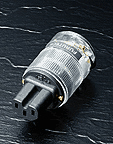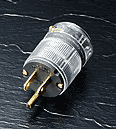You are reading the older HTML site Positive Feedback ISSUE 10october/november 2003 furutech FI-20 gold AC connectors as reviewed by Max Dudious
|
Max Discovers Furutech: A brief note In my discussions with Ye Olde Editor about how much we still don’t know, I was struck by how certain audio issues remain in the dark. Consider the cleanest way of getting the electrons from the power plant to the wall socket, and from there to our sound systems. One of the better examined items has been traction for optimum contact from one connector to the other. Wide, flat horseshoe connectors on loudspeaker cables have come back into fashion, at the expense of banana jacks, for one example. Sometimes manufacturers come up with clever schemes to generate more gripping power between connectors, like expandable and locking RCA plugs, and when they work as advertised we say, "How ingenious!" At other times we read of new and equally clever theoretical schemes to insure optimal contact that, in practice, yield promises unfulfilled, and we say, "How dorky!?!" And that is the difference between the apparently Rube Goldberg invention that works, and those that don’t. So it was with a jaded skepticism that I hesitated to jump up and down when Art Almstead, the chief designer at Twisted Pair Design, sent me a pair of AC cords to listen to that featured terminators by Furutech. These were to be A/B compared on my Parasound Halo JC-1 amplifiers matched to Art’s previous design that used Marinco and Wattgate terminators. The cable itself had the same wire, insulation, roped lay, and bleed-to-ground scheme. The only change was the substitution of the Furutech terminators. Upon superficial examination, how different could one three-pronged plug, or IEC connector, be when compared with their competition, Marinco three-pronged plugs, and Wattgate IEC connectors. Each is a highly respected product. The metals used look alike. The housings look alike. When I plugged them in, though, I felt a great deal more resistance, as if the tines fit more tightly and were faced with greater friction. Upon re-examination the tines were (somehow) spring loaded. That was a first. And I’m told the female IEC connectors are similarly spring loaded. Theoretically, if the blades, or tines, of the three pronged plug do not fit exactly they would make contact at only one point. This point would describe the apex of a right-triangle. The two contacts would describe the two long legs of the triangle, and the somewhat wider space at the bottom would describe the third. The angle at the apex would be quite shallow, perhaps approaching a few degrees. The space of the right triangle would look like the cross section of a shim. As the current draw increased due to louder passages passing through the amplifier, for example, the current could easily arc which would create something like a "dioding" effect, subjectively experienced as "high frequency hash." This is one hypothesis: the spring loaded Furutech terminators make longer, flatter contact, eliminating or greatly reducing "hash." Another has to do with metallurgy. Furutech uses non-magnetic metals when possible, often PCOCC (Pure Copper by Ohno Constant Casting) copper–to be exact. This six nines copper (99.9999% pure) is often used in interconnect cables, speaker cables, etc. and is considered among the best for audio purposes due to the copper crystals lining up in greater number. Furutech advertises an Alpha Process that is a "Super cryogenic & demagnetizing treatment." I’m not sure if that is what is used for the parts in the three-pronged plug, or not (Furutech sometimes also uses bronze), but they are at least alert to the phenomenon of crystal alignment. In any case, the metal is then plated with gold in a "special precise process." There are some of us obsessive compulsive enough to sit up late at nights and listen to various RCA female chassis jacks. In such listening tests, gold plated directly to copper (eliminating the shinier nickel intervening layer) was usually a noticeable notch cleaner, as in the top-of-the-line Vampire connectors. I know Art Almstead imports his RCA plugs from Australia because they are well thought out metallurgically. His manufacturer uses an intervening layer of silver that is said to be nearly neutral sonically. So the second hypothesis is: the Furutech plugs have better metallurgy, reducing or eliminating "hash." This combination seems to bear fruit with the Twisted Pair AC cable. My CSPAN buddy, 40 year old Paul Loeschke, and my college kid neighbor, 20 year old Nathanial Meysenburg, were around at the time I did this comparison. Without coaching, or theoretical explanations, they each commented that the cymbals were "less fuzzy," the symphonic orchestra seemed somehow somewhat "bigger," a solo violin was "cleaner," and the whole event seemed "more vivid." Later on I tried to describe my twin hypotheses to them. Hearing this, La Dudeen (my wife) commented, "You should know better than to expect a nice clean uni-causal explanation. Clearly the mechanical and metallurgical improvements both contribute to cleaner sound." She has a strong background in the sciences. So what we have here is a great example of how things improve by small increments. Who’d have thought the plugs connecting my Monster AVS 2000 Automatic Voltage Stabilizer to my John Curl designed Parasound Halo JC-1 amplifiers would clean up the sound even one discernable notch. I think the human ear has a particular sensitivity to the region of 3 kHz - 6 kHz, and is annoyed by distortions in that region. Getting the audio gremlins out of this particular region brings a great deal of satisfaction to my 60 year old ears. (You’ll note in my pseudo-scientific way I arranged to have a 20, a 40, and a 60 year old set of ears working on this evaluation.) I must say that I haven’t heard each and every one of the growing number of AC cords out there, but Art Almstead’s Twisted Pair, Furutech Version, is damn clean, and though relatively modest in price, I think it invites comparison with the best and most costly AC cords out there. It certainly allows me to hear more deeply into the music without irritating hash. Nice job, Art. As my young neighbor, Nat, says, "Wow!" By the way: about that Parasound JC-1… Those of you who regularly read my screed will note that the Parasound JC-1 amplifier was named among Stereophile’s "Products of The Year." I concur. Congratulations to the gang at Parasound; Richard Schram, John Curl, Carl Thompson, & Bob Crump. I think I’ll give that product my Max Dudious’s "Product of the Year" award. It seems almost everyone agrees, it is one hell of a great sounding amp, and a model of design and production to meet a reasonable price. I hope you who acquire a pair will be wise enough to couple them to Twisted Pair’s Furutech AC cords. You won’t be sorry. I guarantee that. See http://www.twisted-pair-design.com and also http://www.furutech.com for more details.
|


